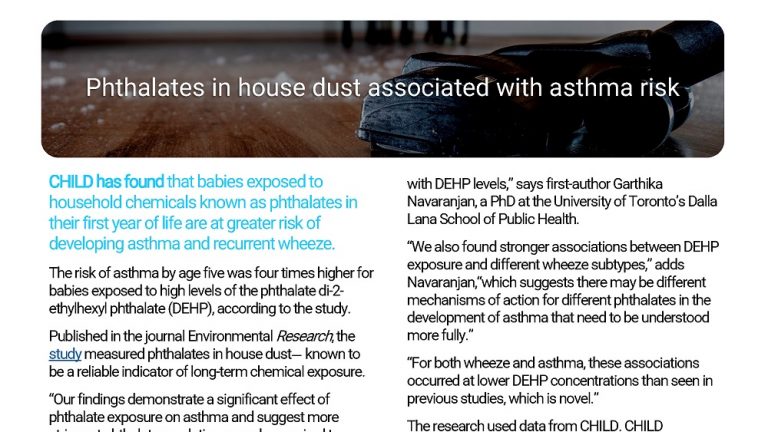Phthalates in house dust associated with asthma risk
CHILD has found that babies exposed to household chemicals known as phthalates in their first year of life are at greater risk of developing asthma and recurrent wheeze.
The risk of asthma by age five was four times higher for babies exposed to high levels of the phthalate di-2-ethylhexyl phthalate (DEHP), according to the study.
Published in the journal Environmental Research, the study measured phthalates in house dust, which is known to be a reliable indicator of long-term chemical exposure.
“Our findings demonstrate a significant effect of phthalate exposure on asthma and suggest more stringent phthalate regulations may be required to protect children’s health,” says senior author Dr. Jeffrey Brook (University of Toronto), the Scientific Director of the Canadian Urban Environmental Health Research Consortium (CANUE).
EVERYWHERE CHEMICALS
Called “everywhere chemicals” because they are so common, phthalates are found in a variety of household products including plastic toys.
Phthalates leach out over time into the surrounding environment, including dust in homes.
The study also found that infants with high levels of DEHP exposure had a significantly increased risk of recurrent childhood wheeze – a common symptom of future asthma.
“There was a two-fold increased risk of recurrent wheeze between two to five years of age associated with DEHP levels,” says first-author Garthika Navaranjan, a PhD at the University of Toronto’s Dalla Lana School of Public Health.
“We also found stronger associations between DEHP exposure and different wheeze subtypes,” adds Navaranjan,“which suggests there may be different mechanisms of action for different phthalates in the development of asthma that need to be understood more fully.”
“For both wheeze and asthma, these associations occurred at lower DEHP concentrations than seen in previous studies, which is novel.”
The research used data from CHILD. CHILD researchers conducted a standardized home visit with over 3,000 CHILD families to obtain urine and house dust samples when the babies were three-to-four months old. Analysis of the urine samples showed that all infants had been exposed to phthalates.
“It’s not just in the dust, it’s in their bodies,” says Dr. Brook.
BETTER REGULATIONS NEEDED
“These results suggest that current phthalate regulations are missing a link to important chronic diseases of public health importance,” comments Dr. Christopher Carlsten (The University of British Columbia).
“We will continue to look closely at the rich information collected in CHILD to identify where high levels of DEHP are coming from, and to help inform strategies to reduce their levels,” adds Dr. Brook.





